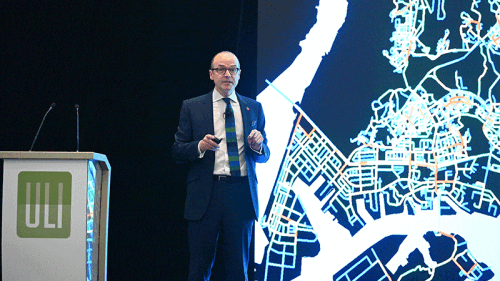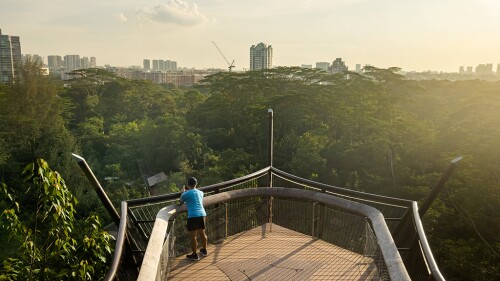Asia Pacific
Insights, trends, and innovation shaping real estate and urban development across the Asia Pacific region’s dynamic markets and cities.
The Greater Sydney Commission (GSC) has prepared a 40-year vision for connecting and rebalancing growth and development in Greater Sydney, one of the fastest-growing regions in the developed world. In an event organized by ULI Australia and Urbis, GSC chief commissioner Lucy Turnbull presented the keynote, outlining how land use, transport, and infrastructure planning for the growth areas have for the first time been prepared concurrently.
Niche strategies and development are high on the agenda for investors looking to hit their return targets in South Korea. A group of private-equity real estate managers gathered at the ULI South Korea Annual Conference, held in Seoul in January to discuss capital markets in Korea and further afield.
China is a nation of more than 1 billion “digital-first” consumers, Jeffrey Towson, managing partner at Towson Group and a Peking University professor, said at a recent ULI event in Shanghai. Because these consumers are starting to act like an interconnected network—influencing each other and generating fresh ways of doing transactions—they are shaping how almost all companies do business.
Improved connectivity leads to better cities and more profitable buildings, and data can play a crucial role in analyzing that connectivity and planning to maximize it, said a keynote speaker at the ULI Asia Pacific Leadership Convivium in Singapore.
When e-commerce first became entrenched in China, it seemed to sound the death knell for traditional retail. Sporting venues and other cultural attractions are helping bring foot traffic to the experiential retail of the future, said panelists at a ULI event in Shanghai.
Members of ULI’s Asia Pacific Tech Council discuss the new council’s areas of focus, the interface between technology startups and the real estate industry, the challenges of incorporating rapidly evolving technologies, the promise of big data, and related trends.
After several years of steady growth, Asia Pacific real estate continues to produce strong returns, but caution is increasingly embedded into investor strategies, according to Emerging Trends in Real Estate ® Asia Pacific 2020, an annual real estate forecast jointly published by ULI and PwC. Singapore, Tokyo, Sydney, and Melbourne are ranked as four of the top five markets for investment prospects, reflecting investor preference for regional markets that are large, liquid, and defensive.
Pragmatism and caution have defined China’s 40 years of economic reform, and this steady progress is set to continue, said Shui On Group chairman Vincent Lo speaking at the 2019 ULI Asia Pacific Summit. Lo—who has been investing in China real estate for more than 30 years—said that the nation’s approach can be summed up by the aphorism “cross the river by feeling the stones.”
The evolution of the workplace is being driven by changing demands and the power of big data, said speakers representing developers, designers, futurists, and millennials at the 2019 ULI Asia Pacific Summit in Shanghai.
ULI Philippines is creating the first ULI Library outside the United States in Bonifacio Global City (BGC), Manila. Named the BGC–ULI Public Library for Urban Sustainability (BU+PLUS), the new facility will be located on the covered roof-deck penthouse area of the De La Salle University Rufino Campus. The library is scheduled to open by the third quarter of 2019.
Singapore
The 2026 Emerging Trends in Real Estate® Asia Pacific report, published jointly by ULI and PwC found a mood of cautious optimism among real estate professionals; however, respondents described considerable disparities in markets and sectors across the region. Tokyo was ranked as the top city for investment in the Emerging Trends survey, top of the table for the third consecutive year, followed by Singapore, Sydney, Osaka, and Seoul.
A seminar organized by the ULI Singapore NEXT Committee presented attendees with the little-known concept of real estate “tokenization,” or fractional investing/trading, as a potential bridge between private investors and direct ownership. Although not new, tokenization in real estate is a niche market, particularly in Asia Pacific, with Singapore hosting a small number of the specialized digital platforms.
Once the site of an abandoned quarry, Singapore’s Rifle Range Nature Park now serves as a buffer zone protecting one of the island nation’s last primary rainforests, Bukit Timah Nature Reserve, from encroaching development and human activity. Located to the reserve’s south, Rifle Range is Singapore’s first net-positive energy nature park, harvesting more energy than its annual operational requirements.
Hong Kong
Growing cities such as Hong Kong are at the epicenter of what Richard Florida has dubbed “the new urban crisis,” with the city’s success sending house prices soaring out of reach of the average resident. The author and urbanist, who is director of cities at the Martin Prosperity Institute at the University of Toronto, spoke at the 2018 ULI Asia Pacific Summit in Hong Kong.
While investment volumes in commercial real estate in Hong Kong were up strongly last year, flagship office buildings and prime development sites are beyond the reach of all but a handful of players. For most investors, more interesting opportunities lie in other, less-visible parts of the market. Rather than waiting for (and possibly missing) the next correction, investors who are willing to roll up their sleeves may find opportunities away from the spotlight.
At a recent event hosted by ULI Washington, panelists discussed how U.S. and Chinese companies are continuing to work together. After record levels of U.S. investment from China in 2016, new controls on capital outflow and investors’ changing attitudes have slowed inflows, while domestic development in China has also shifted.















